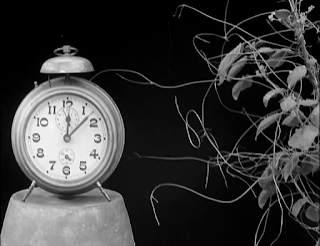Seeing life so strangely, we inevitably try to reconcile
these unrecognisable patterns and to draw parallels to the safer, known
macro-universe. As the very RP voiceover says during the description the fungal
Plants of the Underworld (1930) one
of the extras, Nature is the most “grotesque artist in the World.” Magnified
20,000 times the growth of the fungal cells is alien and unsettling… still
entrancing and fascinating all the same.
Between 1909 and 1943 Percy Smith made a sequence of
extraordinary documentaries after the former clerk for the British Board of
Education had impressed producer Charles Urban with a close-up of a
bluebottle's tongue. From The Acrobatic
Fly (1910), The Birth of a Flower
(1910), The Strength and Agility of
Insects (1911) to Life Cycle of the
Newt (1942) and, my favourite, Life
Cycle of the Pin Mould (1943) Smith kept his subjects closer than any
film-maker in history.
There are eight shorts from Smith on the set which
compliment those already released by the BFI on the Secrets of Nature DVD. Minute
Bodies itself is what the BFI term an “interpretive edit” of original
footage compiled by Staples himself. The result is spellbinding and succeeds
emphatically in pulling you into Smith’s world of impassioned patience.
It’s an “analogue” experience and the music is suitably “organic”
featuring the largely non-digital sonic pallet of a band rooted in earthy
deliberation: there’s no rush to make musical points with the ‘sticks!
 |
| A mighty ant! |
Stuart A. Staples has previously said that having
originally been fascinated by Smith’s images he came to want to tell the story
of their creator through this strange and powerful micro-cinema. So, odd as it
may seem, Minute Bodies turns out to
be a musical biography of the man from North London who photographed moss
growing in his spare time. A man who, in the interests of scientific discovery,
wasn’t afraid of working with small insects, pin mould and animation.
Watching unknown cellular organisms scuttling across the
screen, strange moulds advancing to attack each other and animalistic plants
writhing their way sun-ward you get a feel for the character of the person
taking such obsessive care over the production of these images. As hobbies go…
micro-cinematography is all-consuming but, what joy in these ever-present but
unexpected glimpses of the life underneath us. It’s unsettling and the score
works that feeling – this is a brutal little world.
But Smith’s work is not without a very English sense of
humour and there’s a lovely syncopated section showing micro-organisms at play…
or it feels that way!
The project took three years of stop-motion musical production between Staples and co-producer David Reeve before the full Tindersticks were convened to record the music. Staples’ music takes care and works sympathetically with his subject to create that new narrative. The music is restrained as you’d expect from such experienced soundtrack performers who deftly combine elements of post rock, electronica and the emphatically-acoustic.
It is only at the end when we see Smith, his profile
close-up to a rat and then full-on with four of the rodents climbing around his
neck. One nips his throat, he smiles and calmly pulls it back: in his element
with his beloved nature; respecting his subject matter.
Smith said that he aimed to provide "the powder of instruction in the jam of entertainment" and
Mr Staples and the Tindersticks do the same. They pull together to entrance you
in this world we take for granted as we power our way through the day-to-day…
Stop, listen and learn.
Minute Bodies is
available NOW from the BFI on Blu-ray and DVD – you can order it direct from here along with Secrets of Nature.
The soundtrack album is also out and is available from
the Tindersticks' website along with a trailer to tempt you all!
 |
| Percy works the camera |















No comments:
Post a Comment